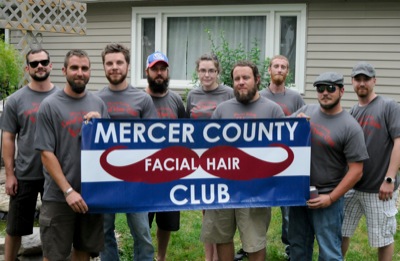Thursday, July 25th, 2013
Local man with Legionnaires' disease dies
Victim was one of two workers at AAP with the illness
By Shelley Grieshop
GRAND LAKE AREA - A 37-year-old St. Marys man - one of two local residents recently diagnosed with Legionnaires' disease - died nearly two weeks ago.
A state official on Wednesday confirmed that both victims, including the survivor who resides in Mercer County, worked at AAP in St. Marys. The factory, which manufactures aluminum automotive wheels, is being investigated as the source of the illness but its more than 400 employees reportedly are not at risk.
The deceased is Brian J. Kyburz, a father of five who passed away July 12, his fiance, Lisa Miller, told the newspaper this morning. Miller said Auglaize County Coroner Dr. Thomas Freytag told her on Tuesday that Kyburz' death was due to Legionnaires' disease, an illness that infects the lungs.
The name, age and condition of the second AAP worker confirmed with the disease has not been released by health officials. Auglaize County health officials and an AAP spokesman said press releases would be released this morning but none were received by the newspaper's deadline today.
Deb Scheer, an epidemiologist for Mercer, Auglaize, Van Wert and Allen counties, said the first local case of Legionnaires' disease was confirmed about three weeks ago; the second case was confirmed July 15.
"This is a very fragile investigation," she said Wednesday, refusing to provide details about either case.
Scheer said no new or suspected cases are currently being investigated. She noted the disease cannot be spread from one person to another. It can be contracted by breathing in a mist or vapor contaminated with Legionella bacteria, which is commonly found in air conditioners, humidifiers, water fountains, misters and showers.
"This is something we all come in contact with all the time," she said. "Most people have a natural immunity."
The Legionella bacteria grows faster in warm or stagnant water and also can be found in natural environments such as ponds and streams, according to the Centers for Disease Control and Prevention.
Miller said Kyburz had cold symptoms a few days before his death but was generally in good health.
"He was a religiously healthy man," she said.
Kyburz, a melter/rover at the factory, worked long hours on July 8 and 9 and showed signs of exhaustion, which his family considered natural for the hours he had worked. His breathing eventually became labored and by July 10 he sought medical treatment for pneumonia, Miller said.
"They gave him an antibiotic ... but by (July 11) he was worse. They wanted to see him again the next day but Brian said we didn't have the money and we needed to give the antibiotics a chance to work," she said.
Hours before his death at 8:45 p.m. July 12, he was taken to Joint Township District Memorial Hospital, St. Marys, where his condition quickly deteriorated, Miller, 36, said through tears. Before he could be transported to Lima via an awaiting emergency helicopter, he died, she said.
The couple were due to marry Oct. 15.
"Brian is and always will be my best friend and the love of my life," she said. "I don't understand how he went from having a cold to dying."
Officials believe the source of the Legionella bacteria that sickened the local residents was at the AAP plant, but stress the company did nothing wrong.
"There is nothing they could have done ...," Scheer said. "The facility has been good to work with and very pro-active."
Ohio Department of Health spokeswoman Tessie Pollock said the company immediately followed recommendations to "super heat" and chlorinate all water source areas. She, too, confirmed that AAP officials offered their "full cooperation" through the investigation.
Symptoms of Legionnaires' disease, also called Pontiac fever, can include fever, chills, muscle aches, headaches, fatigue and loss of appetite. Most people infected with the Legionella bacteria aren't tested for the disease unless symptoms become severe. Pneumonia is often diagnosed and patients typically recover if treated early with antibiotics, health officials said.
The disease can be deadly to people with compromised immune systems such as the elderly or very young, cancer patients, diabetics, heavy drinkers or smokers.
Pollock said the pair of local cases and an outbreak earlier this month at a retirement community in Reynoldsburg that included two fatalities, prompted a statewide alert.
"We've taken a lot of steps. We're sending out alerts to health departments, health care providers and emergency rooms, warning them to look out for patients with signs of pneumonia," she said.
Five outbreaks of Legionnaires' disease, including the local cases, have been confirmed in Ohio so far this year. It's the most outbreaks recorded in the last six years, Pollock said. The state has investigated 233 individual cases since January; the highest number reported in the last six years was 390 in 2011.
The Grand Lake area investigation is being handled by Scheer, the Auglaize County Health Department, the CDC and the Occupational Safety and Health Administration.
Facts:
• Legionnaires' disease is caused by the Legionella bacteria, named after an outbreak in 1976 when more than 200 people at a Philadelphia convention of the American Legion contracted the illness.
• Legionella bacteria are found naturally in the environment, usually in warm or stagnant water. Exposure can occur by inhalation or drinking contaminated water.
• People can contract the illness by breathing in a mist or vapor that has been contaminated with the Legionella bacteria. Common sources are humidifiers, water fountains, misters, showers, faucets and whirlpool baths.
• The disease cannot be transmitted from person to person.
• Symptoms such as slight fever, headache, body aches, tiredness and loss of appetite often occur within two to 10 days.
• The majority of people with the disease will contract pneumonia (lung infection) since the bacteria grows and thrives in the lungs.
• Treatment includes antibiotics, which can reduce the severity and increase the chance of recovery if taken early.
• An estimated 8,000 to 18,000 people in the U.S. are hospitalized with the disease each year.
– Centers for Disease Control and Prevention
Correction:
The victim, Brian J. Kyburz of St. Marys, sought medical treatment for bronchitis, not pneumonia, and it was his fiance, Lisa Miller, not medical professionals, who wanted him to
seek further medical treatment when antibiotics didn't appear to be working.
The errors were made in reporting.


